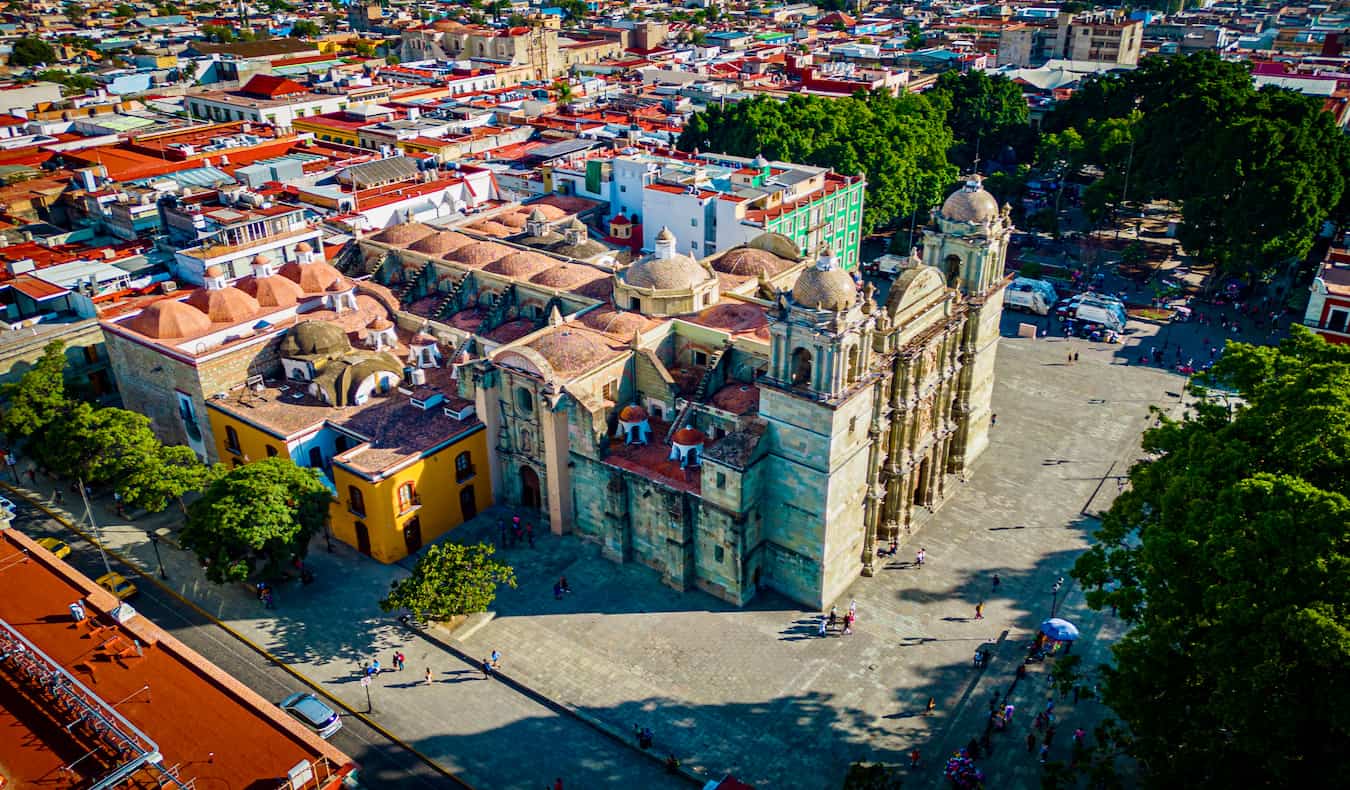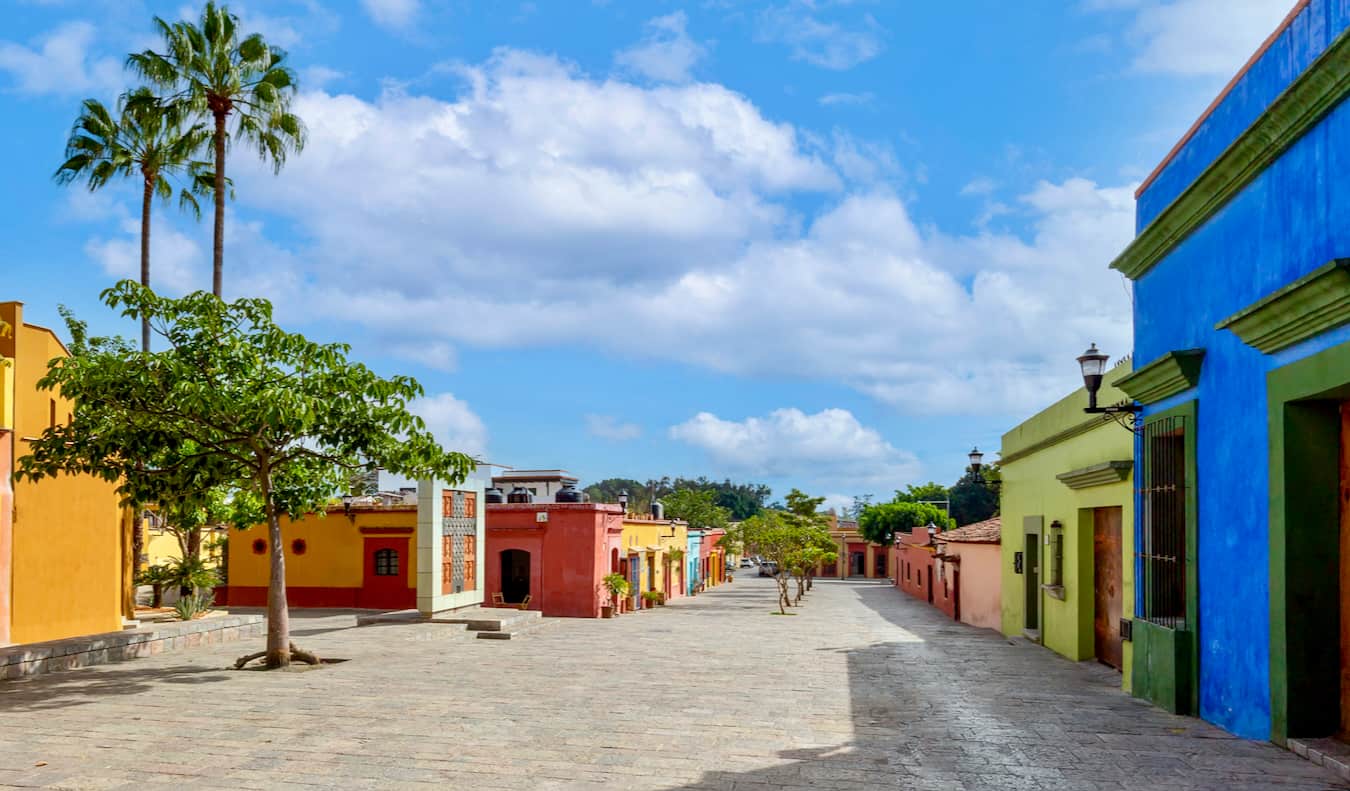THE 15 BEST THINGS TO DO IN OAXACA

Oaxaca stole my heart. I was enamored by this colorful and vibrant city from the moment I stepped foot on its cobblestoned streets. It has it all: history, culture, friendly people, food, mezcal. (I love this city so much that we run tours there now!)
While the town may be small, there’s a lot to do here. Its growing popularity post-COVID has seen a rise in a lot of new experiences, tours, restaurants, and art galleries. (The popularity is just not due to Americans and Europeans either. Mexicans also come here in droves!).
With so much more to do now, here is my list of all the best things to see and do in Oaxaca:
1. Take a walking tour

One of the first things I do when I visit a new city is take a free walking tour. They’re the best way to see the main sights, get introduced to the destination and its people, and connect with a local guide who can answer all your questions. My favorite company is Oaxaca Free Walking Tour. They offer free daily tours showcasing the main sights. Just make sure to tip your guide at the end!
2. See the Templo de Santo Domingo de Guzmán
With original construction dating back to the mid-16th century, this Dominican church and monastery was also used as a military building during Mexico’s revolutionary war (1910–20). The interior is incredibly ornate, with intricate carvings on the walls, and it still holds services today (so dress respectfully when visiting).
One part of the complex became a museum in the 1970s: the Museo de las Culturas de Oaxaca, which focuses on Oaxacan culture, with all kinds of religious and pre-Columbian artifacts in its collection. The “Treasures of Monte Albán” exhibition showcases over 400 relics from a Mixtec tomb that is one of the most important burial sites in Mesoamerica, including a skull covered in turquoise, carved bone objects, weaving tools, and jewelry made of gold and jade. It is by far one of the best things to do in the city. You’ll need a couple of hours to see it all.
C. Macedonio Alcalá S/N, +52 951 516 3720. The Museo de las Culturas de Oaxaca is open Tuesday-Friday 10am-3pm. Admission to the church is free, while the museum is 85 MXN.
3. Stroll through the Botanical Garden
Also located in the former convent in the Santo Domingo de Guzmán complex, the Jardín Etnobotánico de Oaxaca features 900 species of plants from across the state, which is one of the most biodiverse areas of Mexico. In addition to the flowers, trees, and cacti, there are sculptures and works of art too.
Admission is via tour only. There’s just one English tour available per day (offered at 11am). It fills up quickly, as there are only 25 spots available, so be sure to arrive early as it is first come, first served.
Reforma Sur, Ruta Independencia, +52 951 516 5325. jardinoaxaca.mx. Open Monday-Saturday 10am-3:30pm. Admission is by guided tour only. Admission (including the tour) is 50 MXN for Spanish tours and 100 MXN for tours in English.
4. Just wander the city
Oaxaca contains over 1,200 historic buildings. One of the best things to do is walk around town and take in the historic buildings, colorful murals, cobblestone streets, and beautiful architecture. Just get lost. Take your time wandering the iconic landmarks like the Zócalo (the main square, in front of the National Palace), the Baroque Cathedral of Our Lady of the Assumption, the murals of Xochilmilco, and the colors (and murals) of Jalatlaco (which is my favorite neighborhood in the city).
5. Explore the markets
Oaxaca is famous for its markets. My favorite is Mercado 20 de Noviembre, a 19th-century covered market where you can indulge in all kinds of delicious street food (fresh, local produce is sold here too). Named after the start date of the Mexican Revolution in 1910, it has remained one of Oaxaca’s culinary and cultural hubs for over a hundred years. I love coming here to wander and people-watch. It’s open daily from 7am-9pm.
I also love nearby Mercado Benito Juárez with its food stalls and shops.
Additionally, there is the famed Abastos market, which is the largest market in the region. You can find everything here. It’s huge. If they produce it in the world, it is here. It’s a little outside the city center but it’s worth the trek.
6. Learn about mezcal
Oaxaca is the birthplace of mezcal and more than 70% of Mexico’s production happens here. Like tequila, mezcal is a spirit distilled from agave, but unlike tequila, the heart of the plant is cooked in a pit in the ground before it is crushed. There are a ton of options to learn about mezcal while you are here. For bars, my personal favorites are Los Amantes Mezcalería, Mezcalogia, Tres Hermanas, Mezcalería In Situ, and Comere.
For tours, take Rambling Spirits. This tour company was founded by two journalists who have developed deep roots with the local mezcal producers and will take you to places the more commercial tours won’t. They have an insane level of knowledge and can teach you everything you need to know about mezcal as well as introducing you to the families and producers. It’s my favorite mezcal tour in the city.
7. Visit Monte Albán
Founded in the 6th century BCE, Monte Albán was one of the earliest Mesoamerican cities and an important sociopolitical and economic center for almost a thousand years. Get context for the rest of your visit by stopping in at the museum first, and then continuing on to wander the sprawling venue, which is filled with ancient Zapotec pyramids, tombs, terraces, and canals. It is super impressive and takes a few hours to see.
This pre-Columbian UNESCO World Heritage Site is located just 15 minutes outside town. There are regular shuttles to and from downtown Oaxaca, or you can visit on a guided tour if you want an expert guide to show you around (it’s the best way to learn more about the site).
8. Take a food tour
Oaxaca is a center for Mexican gastronomy, with some of the most diverse selections of dishes in the country. Some popular dishes include:
- Tlayudas: a thin and crispy corn tortilla topped with refried beans, pork lard, lettuce, avocado, Oaxacan cheese, and your protein of choice; this is usually a nighttime street food snack.
- Memelas: thick grilled corn cakes with black beans, meat, and cheese toppings.
- Mole: a sauce with dozens of ingredients that varies greatly in preparation (there are seven traditional Oaxacan moles) but often includes cacao, several types of chili peppers, garlic, onion, and other spices; it is served over rice, meat, and tortillas.
- Tetelas: corn tortillas stuffed with black or refried beans, cheese, and cream.
I highly recommend exploring Oaxaca’s local food scene with a guided food tour. Oaxaca Eats runs several tours. You’ll get to sample 20+ dishes. Tour prices vary, but expect to spend 2,000 MXN. They are a local owned company that I think runs the best tours in the city. I use them for all my group tours and when I take friends there.
9. Swim at Hierve el Agua
Hierve el Agua is one of the most beautiful natural sites in the country. These calcified waterfalls have been created over millennia as water from natural springs cascades over the side of cliffs. Similarly to how stalactites form in caves, the minerals from the water create bright white rock formations that look like frozen water.
In addition to admiring and snapping photos of the cliffs, there are also hikes around the falls you can take too (it’s pretty steep so you’ll want to be in good physical shape for them). Bring your bathing suit too as you can swim in the pools on top.
10. Explore Mitla
This pre-Columbian site was one of the main religious and spiritual hubs for the indigenous Zapotec and Mixtec people. Used as a sacred burial ground connecting the worlds of the living and the dead, Mitla was built in 850 CE but mostly destroyed by the Spanish in the mid-16th century. However, some buildings were left intact (some of which date as far back as 400 CE), which you can explore. It stands out from other Mesoamerican ruins due to the mosaics covering the tombs and walls and is well worth a visit.
11. Visit Oaxaca’s artisan towns
The province of Oaxaca is known for its small folk-art villages, each specializing in different handicrafts. Visit one or a few to meet the artisans, see how traditional goods are made, and bring back a souvenir. Teotitlán del Valle is known for its textiles, San Bartolo Coyotepec for black pottery, and San Martín Tilcajete and San Antonio Arrazola for alebrijes (brightly colored, fantastical animal sculptures — you can even take an alebrije-making workshop in San Martín Tilcajete).
You can visit by rental car, local buses, or a guided tour that goes to a few villages.
13. Try a street-stall hamburguesa
The hamburguesa is a delicious must-eat fast food meal. It’s a burger topped with a hot dog, sliced cheese, Oaxaca cheese, ham, pineapple, lettuce, tomato, and jalapeño. It’s all the unhealthy foods you could ever want for just 50 MXN. I know it’s weird to include this as a “must see thing to do” but trust me, you’ll want one. And it’s not made for Gringos and tourists either. Locals devour these. You’ll see stalls all over town but Cangreburguer sells one of the best in my opinion.
14. See the world’s widest tree
The world’s widest tree is located in the town of Santa María del Tule, just 10 kilometers (6 miles) from the center of Oaxaca. Estimated to be 1,500–3,000 years old, this Montezuma cypress (Mexico’s national tree) has a diameter of about 14 meters (46 feet)! It’s a magnificent sight to behold, but as it doesn’t take very long to see, it’s good to combine it with other activities, such a full-day guided tour that also takes you to Mitla and Hierve del Agua.
